Where do I start?
After last year’s race I developed a strong belief that I had learnt enough during my 5 six-day races (2016 to 2023) that in 2024 I’d be able to break the world record.
But the 2024 race gave me many more lessons, and a lot of pain.
Race preparation:
After last year’s race I didn’t do too much training over the summer and then tried to race a 48 hour track race in August which didn’t go well and resulted in a DNF at 31 hours.
I then did even less training and piled on the weight – adding 10kg in the space of just four months from August to Christmas.
I’d been struggling with a hamstring/glute problem since February and had physio from June to August but that wasn’t making any difference. After the August DNF I considered giving up endurance sport completely – which is probably why I sub-consciously put on the weight – but in late November I had an injection into the painful area and restarted physio, and in December I resumed training.
On January 1st I was 93kg and significantly less fit than I had been at the start of any year since I don’t know when.
But I had a plan, and the plan involved being much more professional in my attitude towards the six-day race. Previously I had started the race with an overall goal but no idea how we (this race is a team effort involving many people, not least my wife, Ruth, and my support crew, Sarah) would achieve that goal.
In both the last two years I had a training plan for the 14-18 weeks leading up to the race and I felt that my training had gone well the last two years so I was aiming to replicate that. But when it came to race week I just took things as they came – no plan regarding nutrition and only a rough idea as to how much sleep I was going to have, and when. I also didn’t have any daily mileage goals, let alone breaking each day down into segments with goals for each segment.
So this year we made some major changes:
- Race plan
I created a spreadsheet recording each hour of the race and then marked in when I thought I would want to sleep. My plan was to walk through until late Sunday evening, around 34/35 hours and then sleep for 90 minutes. Then 12 hours later, another 45 minutes. Monday night, another 90 minutes, and then I would fall into a 45 minute sleep every eight hours routine, with a quick massage after each sleep before resuming.
I then worked out that as with previous years I would hold an average pace of 7 ½ kilometres an hour for the first 9 or 10 hours before slowing overnight and eventually settling on a pace of 6 ½ kilometres an hour during day two and 6km per hour for the remainder of the race.
I also built in some contingency for dealing with blisters, unplanned rests, etc.
If everything went to plan, the end result would be exactly 500 miles (805km). - Nutrition plan
Most of my planning was around nutrition. I had never planned what I was going to eat before. My only plan was to eat something every 30 minutes, although often I would forget and could sometimes go a couple hours without eating, or drinking.
Not only did I plan what I was going to eat every 30 minutes throughout the race but I calculated the calories and carbohydrate content of everything I would be eating and drinking, and during every Saturday long walk leading up to the race I experimented with eating 400+ calories and up to 90 grams of carbs per hour to see whether my gut could handle it.
My wife, Ruth, also made some Bolognese sauce, some ratatouille, and some shepherds pie, all packed with plenty of vegetables, to ensure that I would be eating better quality food that in previous races. We froze the food and travelled by train/bus to Vallon Pont d’Arc so that I could take all the food with me, packed in a cooler bag with ice packs.
And for the first time ever, I invested in sport carbohydrate supplements – Tailwind, SIS powder and chews, and Clif Bloks – to enable me to easily increase the quantity of carbohydrate I was consuming each hour.
My training during January, February and March mirrored my training from 2022 and 2023 with the exception that my overall average training pace was 20 seconds per kilometre slower than previous years. I put this down to me carrying too much weight and wasn’t too concerned because I was convinced that my more professional attitude to the race would outweigh any decrease in training speed. I also found that I could still easily walk 32 minutes for 5km in my weekly parkruns. It was just the rest of my training that was slow – although still faster than the pace I was planning on walking for six days.
I also had the disappointment of a DNF in the track 24 hour race I entered in March, but that DNF was due to the constant rain and cold conditions, and not fitness.
Final preparations:
So April finally arrives and on the Wednesday before the Saturday race start I met Kathy Crilley, who would also be competing in the six-day race, and our support crew, Sarah Lightman, at St Pancras railway station for the 12 hour journey through to Paris, down to Valence TGV and on to Vallon Pont d’Arc.
We stayed in an AirBnB on Wednesday and Thursday night before moving into our cabin at the race venue on the Friday morning. Staying in the AirBnB, rather than a hotel, meant that we could eat better food and rest better than the last two years – when we had flown to Marseille on the Wednesday, hotel overnight, then train to Vallon on the Thursday.
It also gave us the opportunity to do some sightseeing on the Thursday.
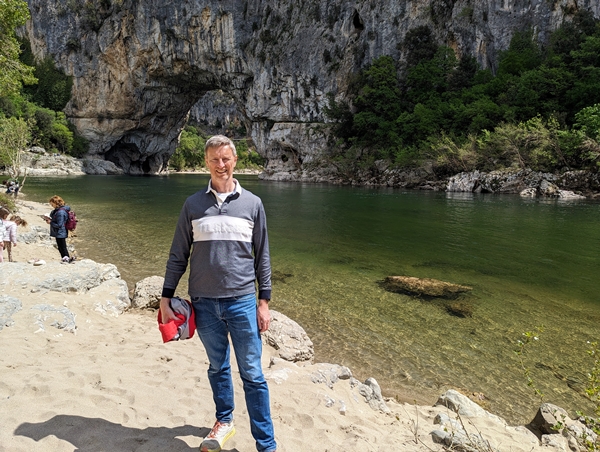
On Friday morning we moved into our cabin – the same cabin we had last year – and it was as if we had never left. After an hour of unpacking we had the cabin set up exactly as we had it last year.
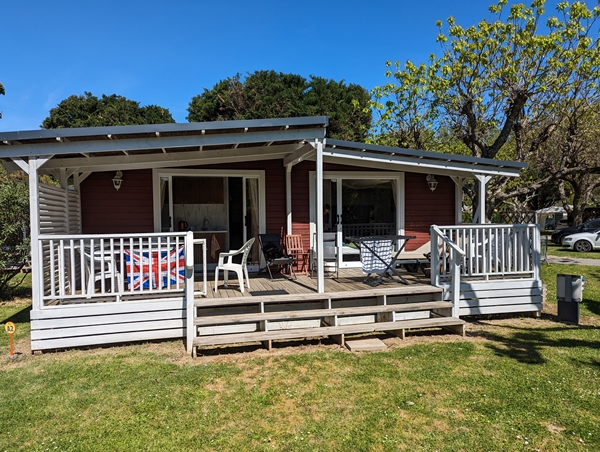
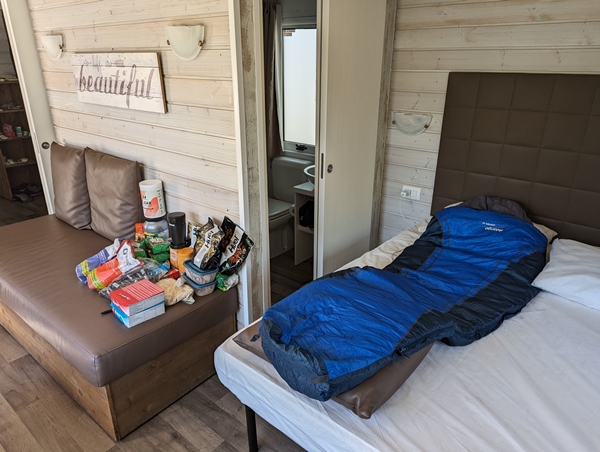
Other than a trip back up to town to do our final grocery shop, the remainder of the day was spent resting and chatting with the occasional other walker or runner.
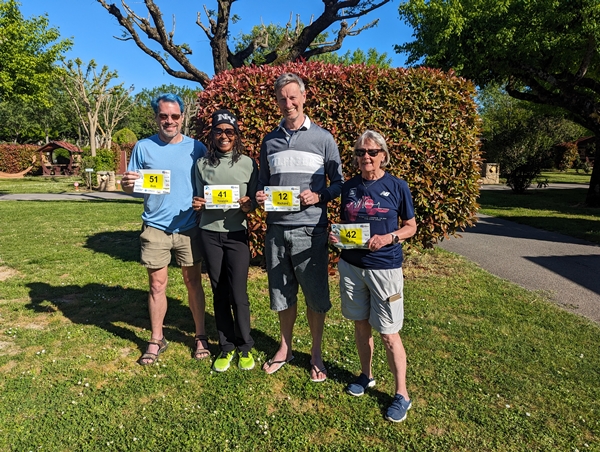
Saturday morning was spent eating and doing final preparations – applying 2Toms blister shield powder to my feet, more eating, resting, keeping off my feet, etc.
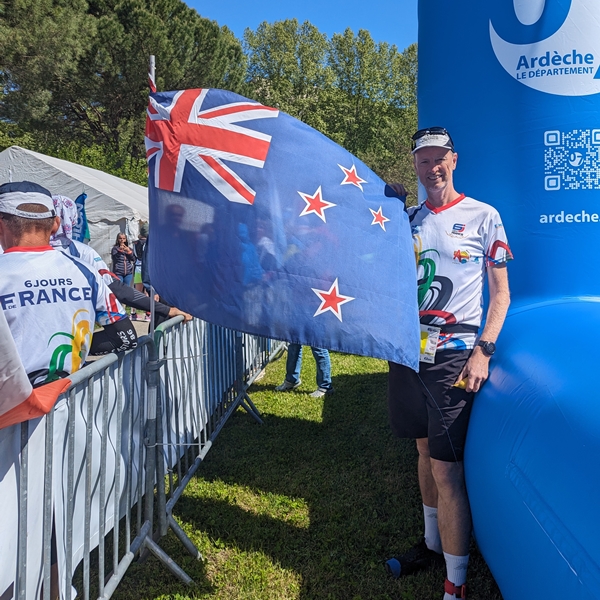
Day 1:
The race started at 12 noon. Day 1 was sunny and warm and the first few laps went by relatively quickly. As well as the 6 day race, there was also a 24 and 48 hour race so the course was busy and the hours flew by.
I started conservatively, compared to many others, and it wasn’t hour 4 that I first took the lead amongst the walkers. For the next four hours though, the lead changed regularly, which was fine by me. At this early stage it wasn’t about racing and I was just focusing on maintaining an even pace, eating every 30 minutes, drinking regularly and enjoying the race.
When we reached 8 hours (just under 60km) the lead changed for the last time, and overnight I slowly increased my lead – to 6km by 2am (100km) and 19km by 8am (142km). This was more because most of the walkers had a sleep break during the first night while my preference has always been to walk through the first 24 hours or more before my first sleep – something that I’m actually going to change next year.
At around 9:30am (21 ½ hours) I felt a hot spot starting to develop under my right foot. I decided to take a quick break to change my shoes – switching from my Brooks to Hokas.
I had two pair of shoes with me – My Brooks Adrenaline size 11, width 4E (extra wide) and my Hoka Clifton size 11 ½ width 2E (which are also extra wide – don’t ask me how the sizing works). Both shoes are wide enough to enable me to comfortably wear two pairs of socks – bamboo liner socks and a normal pair of sports socks. This is exactly the same setup I’ve had for the last two years – same make and model shoes. Same make and model socks.
The orthotics I was using were also the same ones I used last year, which were new in late 2022. The forecast when we left home was for rain during the race and because of my bad experience in the 24 hour race in March, I made a last minute decision to also take my old orthotics, just in case I needed to change them due to them becoming waterlogged or something.
Incidentally, I also made a last minute decision, as I was leaving the house to travel to France, to take my orange jacket that I wore throughout my winter training. The jacket is warm but not waterproof, and initially I had only packed two waterproof jackets based on the forecast – which was rain on and off all week. As I was walking out the door I saw my orange jacket on the coat hanger and thought ‘what if it is cold but not wet’, and packed the orange jacket as well. This jacket ended up getting a lot of wear during the rest of the race because on the Sunday morning a cold wind started to pick up and I ended up wearing the orange jacket for the next five days. It stunk by the end of the race.
Day 1 finished with me passing 100 miles (161km) in 23 hours and 11 minutes (5 ½ minutes slower than last year) and a final 24 hour mileage of 166.2km (the same distance as last year). I led the next walker by 23km.
Both the 100 mile time and 24 hour distance are NZ M55 age group road racewalking records. This is because a) NZ racewalking records are classified as Track if the lap distance is less than 500 metres or Road if longer, and b) no NZ male racewalker in the 55-59 age group is recorded as walking 100 miles or further on a road course (last year I was 54).
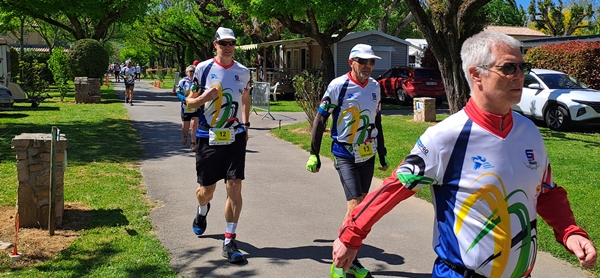
Day 2:
I’d been struggling a little during the last two hours so I decided to have a short sleep after passing the 24 hour mark – 45 minutes with a quick massage from Sarah afterwards. Looking at my lap times while writing this race report I see that the nap didn’t result in a faster pace afterwards but it did remove the tiredness and I continued walking the next 7 hours at an average lap pace of 11:06 – 9:48 per kilometre. This was only about 20 seconds per lap slower than my race plan, but it felt much harder than it should have.
I ended up bringing my scheduled 90 minute sleep forward from 10pm Sunday night (34 hours) to 8pm but according to the notes I was making on my phone throughout the race, I only slept for one hour but had two hours of the track. The additional hour included another massage and some foot maintenance – this was the first time I soaked my painful feet in ice water – and I switched back to my Brooks shoes.
Both feet had become extremely sore during the day with hotspots on the bottom of each foot and small blisters that needed draining. Little did I know at this stage but soaking my feet in ice water was going to become something that I would do twice a day for the rest of the race.
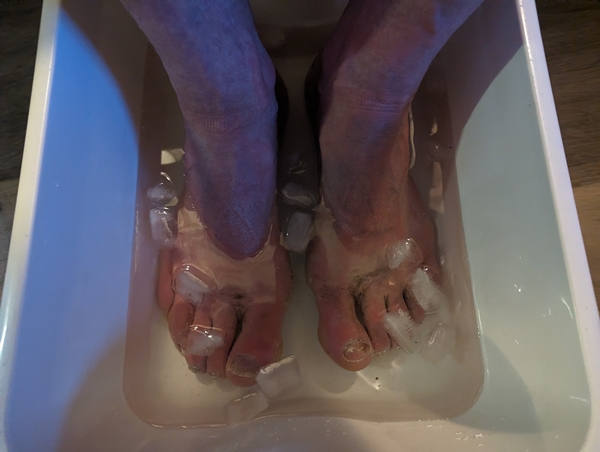
Up until this break I was also recording in my phone how often I was stopping for toilet breaks. It wasn’t as hot as we expected and I was intending on getting a lot of my calories/carbs from drinking Tailwind and SIS. 26 toilet breaks between race start at 12 noon on Saturday and my second sleep at 8pm on Sunday. 26 toilet breaks in 32 hours.
During that time I drank 9 ½ litres of fluid – 3 litres of Tailwind, 3 litres of SIS and 3 ½ litres of water. Why I drank so much water given the cooler than expected temperature, I have no idea, except that on day 1 it was sunny, and although cool and windy I figured that I would be sweating due to the sun.
The course we were walking comprised of an upper and a lower loop with an out and back section linking the two, and a campground toilet block in the middle of the out and back section. This made it easy to quickly stop when I needed to, but next year we will need to monitor this more closely and reduce fluid intake when I’m stopping for toilet breaks too frequently.
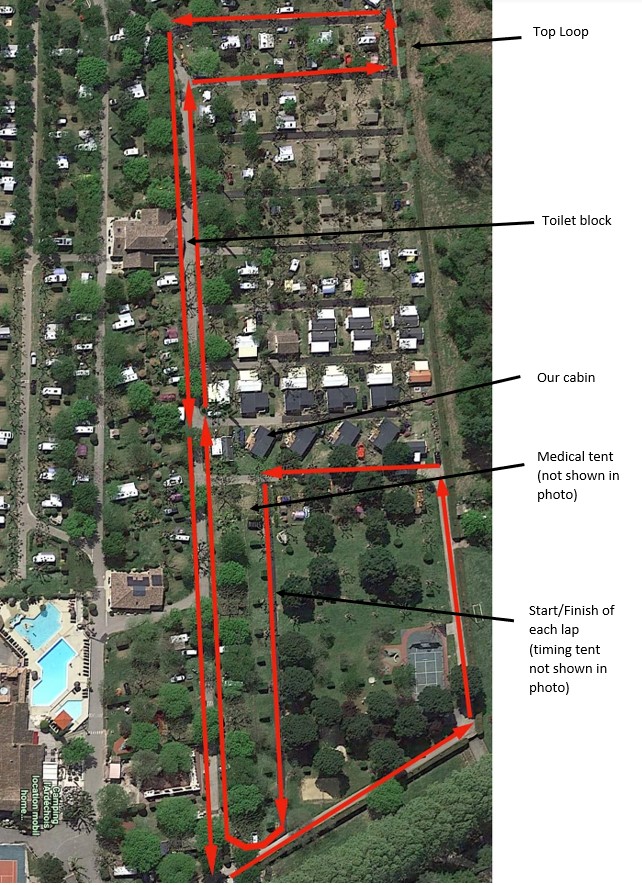
One of the other issues, that I wasn’t made aware of until after the race, was that the timing system shows that on four occasions during the six days, after leaving the toilet I completed a second loop at the top end of the course rather than heading down to the bottom loop like I should have.
This happened because when nature called I found I had to answer quickly, and this meant that sometimes I would stop at the toilet block on my way towards the top loop and sometimes I would stop on my way back. Four times I stopped on my way back, forgot I’d already done the top loop, and did it again. Extra distance of around 300-400 metres each time I made a mistake!
The next 5 ½ hours after my 8pm sleep were painful (mentally) and slow – average pace of 12:50 per lap. I decided to have another sleep at 4am. Sleeping for two hours, and waking refreshed and just on daybreak, I found I felt much better – the best I’d felt in 24 hours.
I walked at a relatively good pace (average of 11:20/lap) from when I woke up through to the end of day 2, reaching 271.4km at the 48 hour mark – which not only was a New Zealand M55 racewalking record but also an M55 running record! Both records previously belonging to Gerald Manderson, whose NZ racewalking records from the later 90’s and early 2,000’s I’ve been slowly breaking over the last ten years.
I was also 1km ahead of where I was at 48 hours last year, well behind my target mileage though. Day 2 was much colder than day 1 and that orange jacket that I’d thrown in my bag as I was leaving home a few days ago became my uniform for the next five days. Whilst not waterproof (it wasn’t raining), it was windproof and warm.
I always struggle on day 2 – 105km this year and 104km both last year and the year before. Excluding breaks, my average walking pace on day 2 was 5.76km/hour, versus 6.98km/hour on day 1. Obviously on day 1 I’m fresh but a drop in average walking speed of more than 1km/hour is too much in my view, and is something I’m going to be working on during the later part of this year.
Interestingly, my day 2 average walking speed (excluding breaks) was faster this year than 2023 (5.37km/h) and 2022 (5.67km/h), but I still felt like I was struggling. See the bottom of this race report for more analysis.
Day 3:
I took a 1 ¾ hour break at the 48 hour mark, slept an hour, soaked my feet again, and swapped back to my Hokas.
And then I walked for 16 hours with just a couple short breaks, including a stop at 8pm to put on long johns because it had become so cold. Normally my legs don’t feel the cold but during the night the temperature was now getting down to 2 degrees, and during the day the cold wind – which we had for pretty much the whole race – kept the temperature in single figures during the day.
I had a quick powernap at 1am and then stopped just before 4:30am for a 90 minute sleep.
Sarah had told me that she would wake up at 6:00am so we planned that I would decide how much sleep I wanted and would come into the cabin that amount of time before 6:00am.
The previous day I was finding that whenever Sarah gave me hot foot to eat, it was getting cold within minutes when I was trying to eat it while walking. So we decided that for breakfast, I’d eat while still lying in bed. It was like luxury hotel service. From day 3 onwards, Sarah would wake me with a bowl of porridge for breakfast which I’d eat while lying in my sleeping bag. While eating that she would make scrambled eggs, and then after I’d eaten my eggs I’d either have a massage and/or soak my feet and then head back out on to the track with some yoghurt or something else to eat while walking.
Mentally, if not physically, I found myself feeling much better after this routine when I headed back out on to the track, although as the race progressed it would take me longer and longer to get back to a proper walk because the long breaks were too long and my feet and legs were painful when I restarted each morning.
I had changed my shoes again after the 4:30am sleep – back into my Brooks – but my right foot, especially, was extremely sore.
As I’ve mentioned, one of the areas I was focusing on this year was my nutrition. Making sure I was eating enough calories and carbohydrates, and Sarah was recording everything I consumed in a spreadsheet for analysis postrace (preparation for next year) and also to ensure I didn’t go long periods without consuming enough fuel, which has been a problem in the past.
Because race rules don’t allow feeding outside of our cabins except in the designated food area – just after the end of each lap – Sarah would either meet me in the food area to hand me food, or leave a range of food on our food table in the food tent and I would message her via Facebook every half hour to tell her what I was eating/drinking. We were allowed to eat food while on the course, but the rules stated that all food could only be handed to the athlete either in their cabin or in the food area.
Periodically, Sarah would message me to tell me what I needed to eat, or meet me outside the cabin as I walked past and tell me what I needed to eat – to keep my calories.
When she was asleep each night I would collect my food/drink from the food area and record what I ate in notepad on my phone, then message the list to Sarah in bulk in the morning.
The system worked well, and I have done some in-depth analysis of my fuelling during the race which I have included at the end of this race report. I’ve also made an appointment to start discussing this with a sports nutritionist so that we can make further improvements for next year.
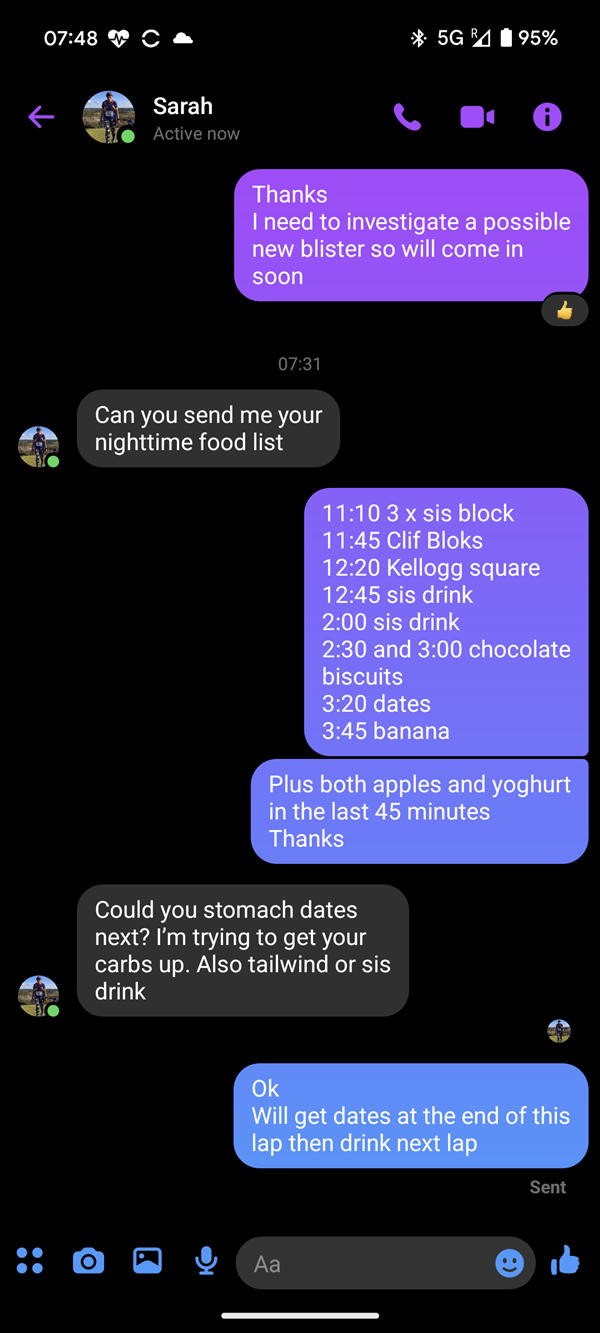
At 10am the pain in my right foot forced me to stop again. Sarah studied the blistering on my the bottom of my right foot and while I was soaking my feet in ice water she researched online and found evidence that this particular blistering could be caused by rubbing from orthotics.
Good news – I had brought my old orthotics with me!
We changed my shoes back to Hokas with my old orthotics and within a few hours I found that the pain had reduced substantially.
By the end of day 3, 72 hours, I had reached 372.1km, covering just 100km on day 3. I was 10km behind the same time last year, but had a 33km lead over Yolanda with another 10km back to Christophe Biet.
I now realised that my painful feet together with the non-stop wind, which was not only making it cold but also making us work that little bit harder, chasing any distance goals was not helping me mentally and I decided that I would just focus on holding my lead.
Day 4:
My next goal was to reach 500 kilometres. Last year I passed 500km in 4 days, 2 hours and 29 minutes, and with 128km still to go it was unlikely that I would beat that, especially as I now found that due to me changing my gait slightly to compensate for the pain in my feet, especially the right foot, I had managed to put too much strain on my quads which were now complaining.
After my 10am sleep I walked another 4 ½ hours averaging 12 minutes per lap before stopping for a 20 minute powernap at 4pm and another short break for a quick massage at 5:30. My quads were really sore but mentally I was in a good place. I kept focussed on my 500km goal.
I grabbed another 20 minute powernap just after midnight but other than that I walked steadily through the night and by 5am when I stopped for my next sleep I had completed 454km and was leading Yolanda by 50km. She had just resumed walking after her sleep as I finished my lap and headed into the cabin.
I was also monitoring how I was going against the runners and found myself in fifth place overall. Over the second half of the race, depending on who was sleeping, when, I would sometimes find myself as high as third place, and I don’t think I ever drifted back out of the top five overall. Not that I was competing with the runners, but it was something else to focus on.
I slept for 1 hour and 40 minutes and once again Sarah woke me with a bowl of porridge, which I ate while lying in my nice warm sleeping bag, followed by scrambled eggs or maybe an omelette.
After breakfast I changed my shoes back to the Brooks and headed out the door with something else to eat, and my focus set firmly on the remaining 46km required to pass 50km.
On checking the results, the gap back to Yolanda was now 36km. I’d been off the track for just over 2 ½ hours during which time she had walked 18km. By my calculations that meant she was walking 7km per hour and I had been averaging just 13:30 per lap overnight – 5km per hour!
I was confident that I could hold on to my lead, but with 50 hours to go, it could be tight.
96 hours, 4 days, came up on the clock and I found myself on 477.3km – 9km down on the same time last year. I had walked 105km in the last 24 hours, and been off the track for 4 hours 23 minutes, not that I was calculating that at the time.
I used to be happy with anything over 100km per day after day 1 of a six-day race, but this was well down on my original race plan (which went out the window days ago) and with me being 9km down on last year (in which I finished with 711km) I was beginning to realise that it would take some kind of a miracle for me to even reach 700km (which was my plan D).
Plan A had been to walk 500 miles (805km), something no one has done in under six days in the modern race-walking era and would have required everything to go right – especially the weather. Plan B was the world record (787km). Plan C was to beat last year’s distance, and now even plan D was looking unlikely.
I still has Plan E – to beat the 660km that Yolanda had walked when she was in the W55-59 age group, Plan F – to break the M55-59 world record of 639km (set by Philippe Clement when he finished 2nd to me in this same race in 2022), and if it came to it, Plan G – to break the 622km NZ M55-59 age group record walked by Gerald Manderson way back in 1999.
I had all these targets recorded in notepad on my phone so that if things started falling apart, as they were, I could reset my focus and not give up completely.
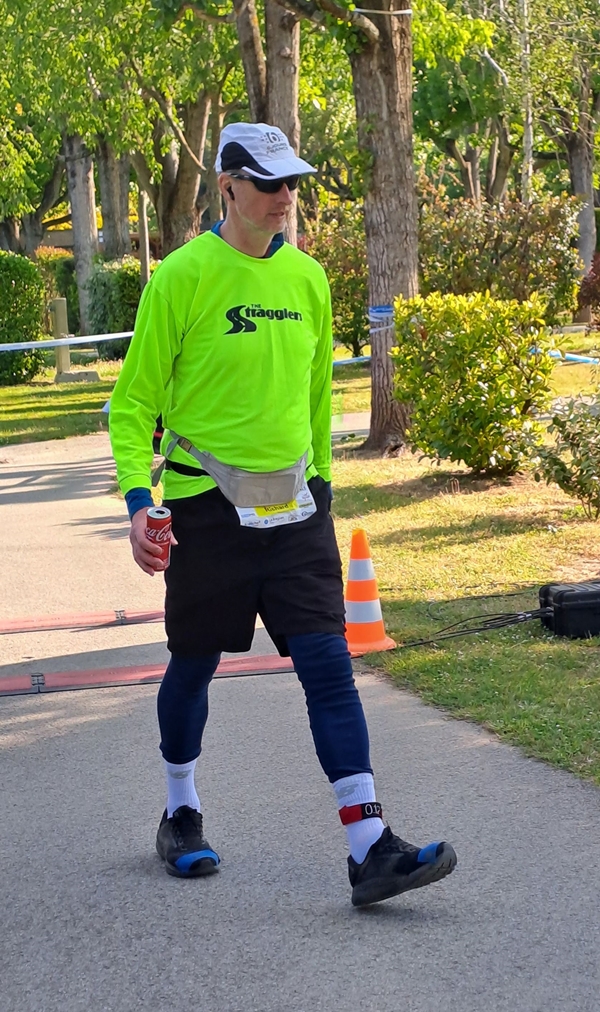
Day 5:
With only 23km to go before I reached 500km (actually 24km because the lap immediately before reaching 500km finished just 20 metres short and therefore to get a 500km time I had to complete another full lap) I kept walking rather than taking a sleep break at the end of the day as I had been doing since the start – or at least that was the intention.
I ended up taking two short breaks a few laps apart, one for a quick massage and some hot food – it was still cold and windy so I preferred to each hot food inside rather than ‘rapidly going cold’ food outside – and second short break for a 20 minute powernap.
I finally reached 500 (501km) just before 6pm. Official 500km time, and new NZ M55 record, was 4 days 5 hours, 58 minutes and 34 seconds. Just under 2 ½ hours behind last year.
My quads and right foot were extremely sore so we made the decision that I would come in for a long sleep, lots of food, soak feet again, massage, etc.
For the previous two hours I had been averaging 14:30 per lap – 12:48 per kilometre. There was no point in continuing at that slow pace – 4.7km/hour – and perhaps a shower might also help.
I had a 36km lead over Yolanda and even if she caught me while I was off the track, I should be well rested and should be able to put distance on her again when she slept later on.
I can’t remember what order we did things in, but I think I had a shower then fell into bed. I remember waking after 90 minutes needing the toilet and I remember Sarah asking me if I was going to get up. I replied “no, I want another 90 minutes sleep” and when she accepted that I remember being slightly surprised – that she would allow me to go back to sleep.
And when she woke me after I’d slept for three hours I remember having the strangest conversation with her. It would have been even stranger for her.
I had been dreaming that Sarah was my controller and I was in some sort of endurance experiment where I had to do whatever I was told. The experiment was to see how much endurance I had and the next challenge was to see if I could plough a path all the way to New York. From where, I don’t know, but it was going to be a long way.
Eventually I came back to reality and learned that I was in a race.
I assume we then soaked my feet while I ate, but I really have no idea. I know I was off the track for a total of just under five hours and slept for three of those – my longest break and longest sleep of the race, and my only shower!
Before leaving the cabin, I also changed shoes for the last time in the race – back to my Hokas – and after resuming walking I checked the results and found that Yolanda was still 19km behind me and had been off the course for the previous hour.
She had a 4km lead over Christophe who was 5km ahead of Claudie.
I knew that baring anything serious going wrong – something that would force me to stop – I would win the race. The question was, could I walk further than Yolanda’s W55 world record of 660km. Not that I’m sexist in any way – we’ve all seen women winning endurance races outright in recent years – but if I was going to break the Men’s 55-59 record, I really wanted to break the overall 55-59 age group world record.
So that became my new goal – 37 hours to walk 160km. Should be achievable even in the condition I was now in.
I walked well during the night, feeling strong mentally, even if not physically. I walked through to just before 7am (8 hours) but at a relatively slow pace of only slightly under 14 minutes per lap. It felt faster and I really didn’t calculate how slow I was walking even when I saw my lap times at the end of each lap.
The good news is that, with the exception of my strange dream and conversation with Sarah, I didn’t have any hallucinations. On night five last year I started hallucinating badly, but one of my aims this year was to avoid hallucinations thanks to improved nutrition and more sleep. My original plan was for 10 ½ hours sleep this year, versus 8 ½ last year. In the end, I actually had 13 ½ hours sleep this year.
At 7am I had a 20 minute powernap and some hot food, and then with it being daylight again I found that I was able to pick the pace up relatively easily, averaging 12 minutes per lap before stopping at 120 hours, the end of day 5, to soak my feet again.
My Day 5 mileage was my worst of the race at only 86km! But with the long sleep and breaks, I’d only walked for 17 ½ hours. Even so, my average walking sleep was my slowest of the race to date at only 4.9km/hour – not that I was calculating that during the race.
Looking back on the race over the last few weeks, I can’t help wondering if I was using my painful right foot as an excuse during day 5 (and day 6) and taking it easy. Could I have pushed myself harder? I think, in hindsight, that yes I could have. But is that because I have quickly forgotten the pain? I don’t know.
At the end of day 5 I was 36km ahead of Yolanda, who was now 17km ahead of Christophe (himself a previous winner of this race when it used to be in Privas), with another 5km back to Claudie.
There was no way I was going to lose this race from here. I had now completed 563.3km and would probably only need one more short sleep, maybe two, during the final day.
I needed 76km to break the M55 world record – should be relatively easy – and 97km to break the overall 55-59 age group world record – again, highly likely if I could complete the next 24 hours without needing too much sleep, and without any major problems.
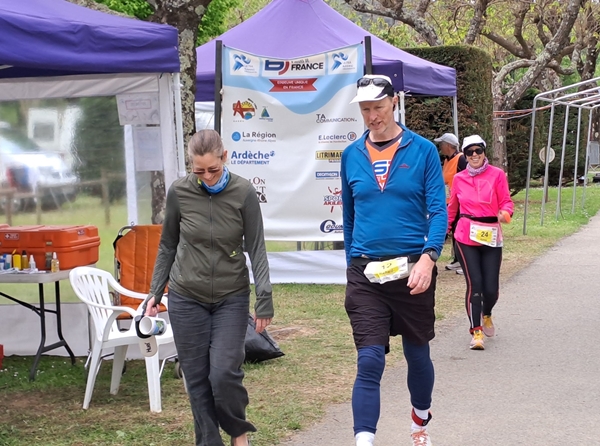
Day 6:
I had a 45 minute break shortly after the end of day 5 to soak my feet, for hopefully the last time, and to eat some more hot foot (multi-tasking 😊) and then walked for five hours at a little under 13 minutes per lap average pace until I decided I needed a sleep at around 6pm. A 30 minute powernap, hot foot and quick massage. It was forecast to rain during our final night so I decided not to put my long johns on. If it rained, wet long johns would be worse than no long johns if it didn’t rain.
It was 7pm when I headed back on to the track. I was at 591km. 48km to get the M55 world record and 69km to get the overall 55-59 world record, and 17 hours left in the race.
It was slow-going overnight. As with every night during the race I received a few phone calls from family and friends in NZ (their day time) which helped to break up the monotony and keep me awake. I was really just going through the motions with lap times ranging from 12 to 14 minutes with the occasional slower lap if I took a toilet break – and slower still when I left the toilets and walked an extra top loop of the course – which is relatively easy to see when I look at my lap times as I’m writing this race report. This is something I need to sort out for next year. No wasted mileage!
I had hoped to walk the last 17 hours without another sleep break, figuring that any time lost sleeping in the closing stages of the race would be hard to make up in the time remaining, but at around 2am I needed one more sleep. It had also just started to rain (lightly) and I needed to stop in at the cabin to get my light rain jacket, so I decided to kill two birds with one stone, as they say, and have a 20 minute powernap. I was at 625 kilometres. 14km to go to break Phillipe’s M55 world record.
As I neared the 639km lap I checked online to find out what his record was – 639.187km – and worked out what lap I would pass that on. As it happened, lap 565 finished at 639.119km, 70 metre short.
If I had been up against the clock, and this was my final lap before the end of the race, then part laps are measured, but I still had over 6 ½ hours to go so I needed to complete lap 566 through to 640.25km before I could call myself the M55 world recorder holder – which I did at just after 5:30am.
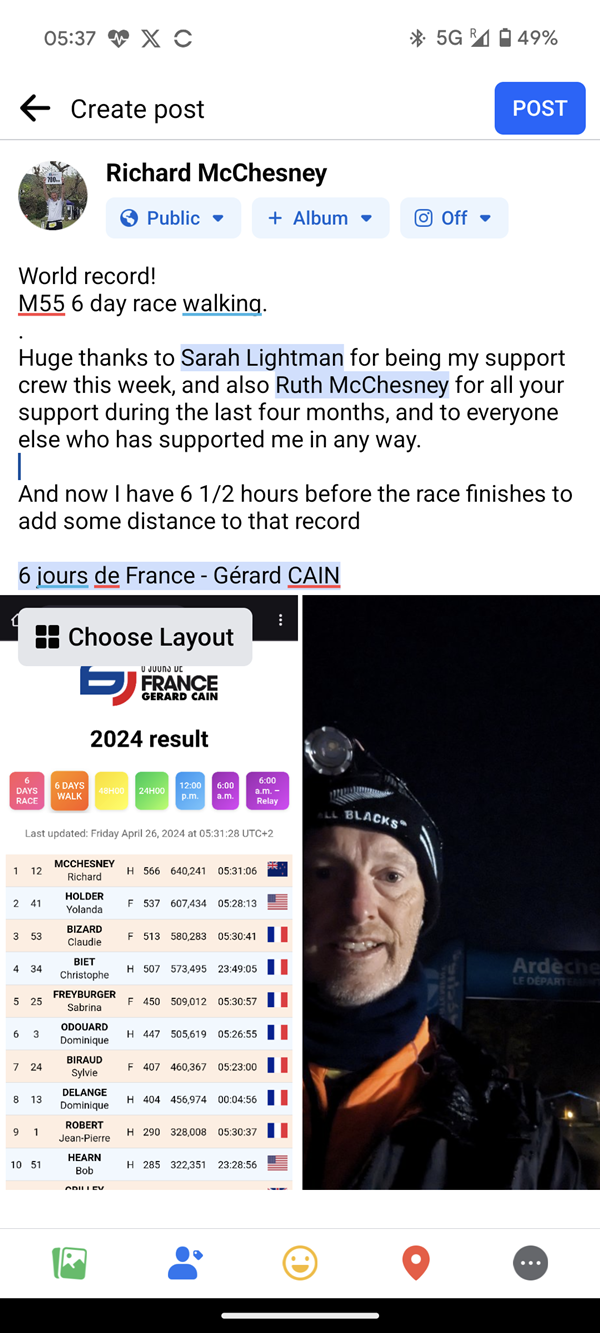
And with 6 ½ hours to walk and only another 21km to pass Yolanda’s overall 55-59 world record, I switched my concerns to Yolanda. She was in a really bad way. She had developed a terrible backwards lean early in the race and was now really struggling and concerned that she wouldn’t beat the female race record of 636km which, while it hadn’t been her primary goal at the start of the race, was now her focus.
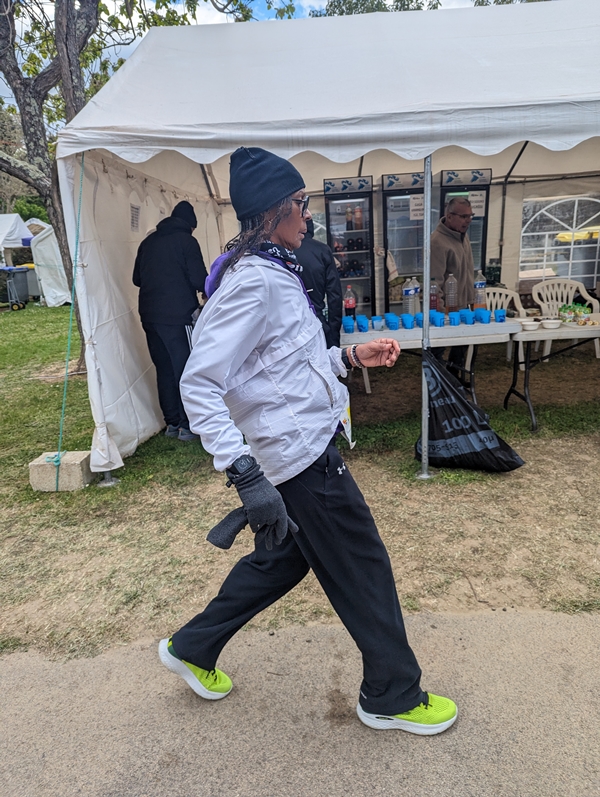
Being American and only used to imperial measurements, she was struggling in her tiredness to convert the distances displayed on the results board into miles so I did the calculations for her and estimated that she was still on pace to complete 400 miles – something she has done five times previously, which is more than any other person in modern racewalking history. By the end of this race, my three 400+ mile results would be the second highest number of 400+ mile results.
However, in my own tired state, I had used the calculator on my phone to multiply 400 x 1.6, which is 640km and I was confident that she would achieve that during the remaining hours of the race. About an hour or so later I remembered that 1 mile is 1.609km and when we are talking 400 miles, that extra 9 metres per mile adds up! I recalculated and identified that Yolanda needed to complete 643.6km to pass 400 miles.
I think at that stage there was probably still four hours left so when I saw Yolanda next I explained my mistake and told her she needed 643.6km to get to 400 miles. She was really out of it though – a state I’ve been in many times – and I don’t think she understood so I just reassured her that she was on pace to break the race record and let her get on with it.
I was now at the stage where I just wanted the race to be over. The leader of the running race, Christian Mauduit, had now passed 500 miles and was also just going through the motions, so we walked a few laps together. Christian has an incredible race pedigree. Not only is he an accomplished six-day runner, with a PB of 871km from back in 2015, he is also the fifth best six-day racewalker in history with his 710km (1km less than my 711km from last year) which he walked in Privas in 2014.
I had always wondered why he took time out (from running) to walk a six-day race and had assumed it was because he was injured at the time. He explained that he had realised that learning to race-walk would improve his endurance running, and the 2014 Privas six-day race was three months before the 2014/15 Across The Years six-day race in Arizona – which is where he ran 871km – so he thought that the ideal opportunity to put his walk training to the test.
Not only is Christian a great ultra-distance runner and walker, but he has also completed deca-ironmans (38km swim, 1,800km cycle, and 422km run) and the Race Across America (RAMM) cycling race (3,000 miles / 4,800km) from the West Coast of the USA to the East Coast, so we talked about that for a while too.
I reached 660km a little before 9:30am at around the same time that the heavens opened and we finally got the rain that had been promised in the forecasts leading up to race day.
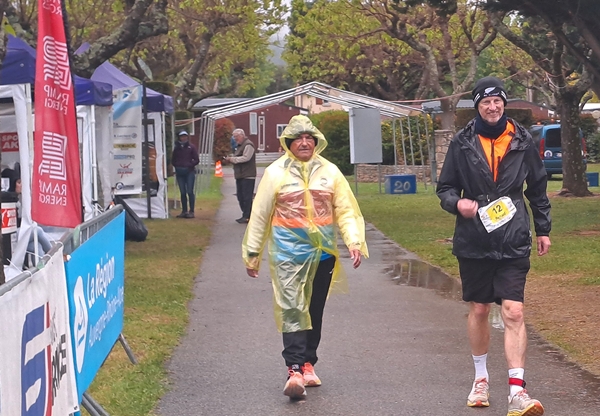
I was already wearing my orange jacket, which isn’t waterproof, and had put my lightweight rain jacket over the top of that, but I now needs my heavy-duty red Goretex rain jacket, which I put on over the top of everything I was wearing.
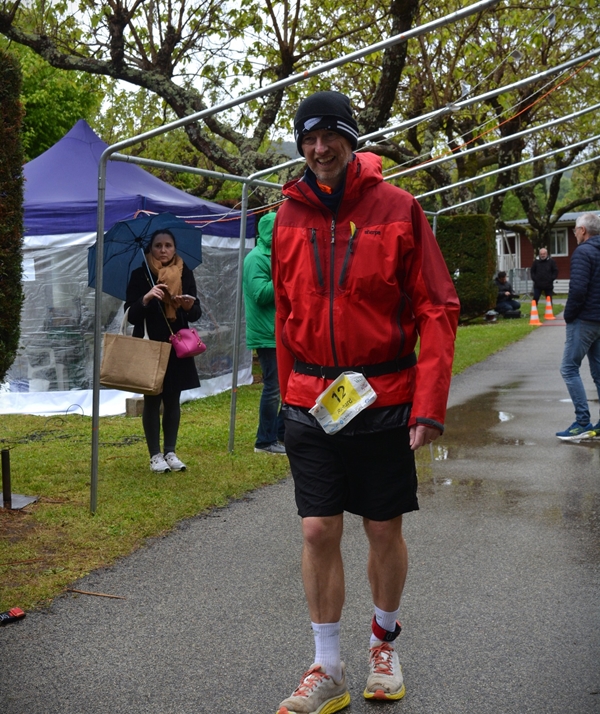
It was wet and cold and now that I had achieved everything that was going to be possible in this race, something strange happened. My quads went completely dead. Every step was painful.
Looking at my lap times, I had been averaging 13 minutes per lap for the previous 6 hours with a slowest lap of 14:37, which was probably a toilet break lap, and suddenly I was only just under 19 minutes. The next laps were 17:31 and 16:16. The heavy rain had dissipated leaving at least three sections of the course flooded, although in all cases we could walk on the grass to get around the flooding.
I walked three more painful laps before the 144 hours was up – 17:54, 19:22, and 20:08.
Not the way I wanted to finish the race, and definitely not like last year when I was celebrating a great race.
With the partial lap measurement I had completed 671.029km in six days – my second best result, but 40km less than last year.
My final day mileage was 107.7km, but for the second day in a row my average walking speed, after removing breaks, was under 5km per hour.
I won the walking race comfortably and placed fifth overall – which was actually my worst placing in the three years we have raced on this course. In 2022 I walked 667km to win the walk and placed 4th overall, and last year my 711km was good enough for 2nd overall.
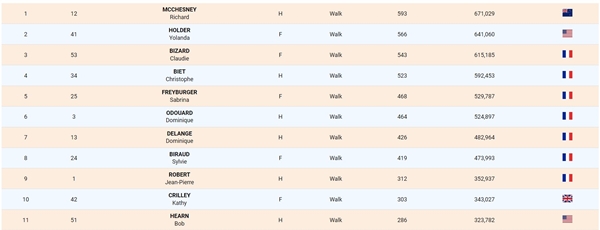
I have to wonder in hindsight, was my foot the main problem, so was it my mind?
Analysis:
My foot problems:
Since the race finished I’ve done plenty of analysis to help understand what happened, and also identify areas for improvement for next year.
The big question is, why did my right foot blister so badly?
In the last previous two years at Vallon I’ve worn the same socks and the same shoes, and other than a few small blisters, I haven’t had any issues (with my feet anyway).
I also train in the same shoes and socks during my longer training walks.
I was also using the same orthotics that I’ve used since late 2022 and used last year.
The course itself has ten 90 degree turns every lap with some of the 90 degree turns being slightly sharper than others due to the width of the path at those corners.
The first three turns are right hand turns and the remainder are left turns. But that can’t be the cause of the blisters. The course has been the same every year.
The only difference was the weather. In 2022 we had afternoon temperatures in the high 20’s and night time temperatures were still warm. Last year was cooler – afternoon temperatures in the low 20’s but still warm through each night. Both years were calm with little to no wind.
This year, however, we had a constant wind, which wasn’t strong, but was always there, and the daytime temperature was in single figures most/all the time and dropped to 2 degrees overnight.
I was also heavier going into the race than the previous two years.
Could the wind, and perhaps my extra weight, have caused the blisters? That is the only think I can thank of.
One thing I’ll be doing next year though, is getting my feet ‘tidied up’ by a podiatrist before a month or so before the race. I always have calluses on the heels and outsides of my feet, and whilst they were the problem this year, if I had developed a blister under a callus, then that could have been very painful.
Nutrition:
Sarah recorded everything I ate and drank during the race. In total, 37,889 calories and almost 7 kilograms of carbohydrate. This was actually less than I was planning, but it felt like I was eating non-stop for the whole race.
I don’t know how much I have eaten in past races but I suspect it would be less than half of this.
And as I’ve mentioned, Ruth had prepared some food for me to take to the race, which meant that I was eating better quality food in the days leading up to the race and in the first few days of the race – while what Ruth had made lasted. Next year we will take more of Ruth’s vegetable laden Bolognese sauce and ratatouille.
This is a list of everything I consumed during the race:
| Type | Unit Qty | Item | Quantity | Calories | Carbs | Mls | Category |
| Food | 1 | Apple | 6 | 580 | 150 | Fruit | |
| Food | 0.5 | Apple | 1 | 48 | 13 | Fruit | |
| Food | 1 | Asda Rice Cake | 8 | 280 | 60 | Processed Food | |
| Food | 0.25 | Asda Rice Cake | 1 | 9 | 2 | Processed Food | |
| Food | 1 | Banana | 8 | 840 | 216 | Fruit | |
| Food | 1 | Bread (white – one slice) | 1 | 76 | 14 | Processed Food | |
| Food | 1 | Chocolate Cadbury Dairy Milk (5 squares) | 2 | 244 | 26 | Processed Food | |
| Food | 1 | Clif Bloks (3) | 38 | 3572 | 874 | Sports Food | |
| Food | 2 | Crossiant | 1 | 462 | 52 | Processed Food | |
| Food | 1 | Crossiant | 2 | 462 | 52 | Processed Food | |
| Food | 1 | Dates (12) | 15 | 3120 | 705 | Fruit | |
| Food | 1 | Del Monte Tinned peaches (1/2 tin) | 4 | 440 | 100 | Fruit | |
| Food | 0.5 | Del Monte Tinned peaches (1/2 tin) | 1 | 55 | 13 | Fruit | |
| Food | 1 | Dole fruit in jelly | 1 | 101 | 25 | Processed Food | |
| Food | 1 | Haribo | 2 | 304 | 40 | Processed Food | |
| Food | 1 | Jacket potatoes (medium size with cheese) | 6 | 2226 | 366 | Hot Food | |
| Food | 0.5 | Jacket potatoes (medium size with cheese) | 1 | 186 | 31 | Hot Food | |
| Food | 1 | jelly babies (8) | 5 | 870 | 210 | Processed Food | |
| Food | 1 | Kellogg’s Rice Krispies Cereal Bar | 3 | 249 | 45 | Processed Food | |
| Food | 1 | Kellogg’s Rice Krispies Squares Marshmallow | 6 | 714 | 126 | Processed Food | |
| Food | 1 | Magnum (mini) | 3 | 408 | 39 | Processed Food | |
| Food | 1 | Milk chocolate digestives (2) | 4 | 500 | 60 | Processed Food | |
| Food | 2 | Milk chocolate digestives (2) | 3 | 750 | 90 | Processed Food | |
| Food | 1 | Muller Rice Pudding 170 Grams | 7 | 1274 | 224 | Processed Food | |
| Food | 1 | Omelette (2 eggs and cheese) | 4 | 1000 | 2 | Hot Food | |
| Food | 1 | Omelette (2 eggs and ham) | 3 | 486 | 3 | Hot Food | |
| Food | 1.5 | Omelette (2 eggs and ham) | 3 | 729 | 5 | Hot Food | |
| Food | 1 | Orange | 3 | 186 | 45 | Fruit | |
| Food | 1 | Pasta with Ruth’s sauce & mince | 2 | 1140 | 104 | Hot Food | |
| Food | 0.5 | Pasta with Ruth’s sauce & mince | 2 | 570 | 52 | Hot Food | |
| Food | 1 | Poridge (half cup) | 7 | 1715 | 252 | Hot Food | |
| Food | 1 | Raisins 50 grams | 4 | 640 | 144 | Fruit | |
| Food | 0.66 | Rice (1/2 pack) & Ratatoulle (1/4 cont) | 1 | 168 | 30 | Hot Food | |
| Food | 0.5 | Rice (1/2 pack) & Ratatoulle (1/4 cont) | 3 | 383 | 68 | Hot Food | |
| Food | 1 | Ruth’s Cottage Pie (200 grams) | 2 | 526 | 46 | Hot Food | |
| Food | 1 | Sainsbury’s Flapjack Bites (4) | 4 | 1072 | 148 | Processed Food | |
| Food | 1 | sausage (1) | 4 | 368 | 2 | Hot Food | |
| Food | 1 | shrimps & banana sweets | 1 | 75 | 18 | Processed Food | |
| Food | 1 | SiS chew (3 blocks) | 10 | 950 | 230 | Sports Food | |
| Food | 1 | Strawberries (4) | 5 | 80 | 20 | Fruit | |
| Food | 0.5 | Toasted sandwich | 3 | 387 | 43 | Hot Food | |
| Food | 1 | Toasted sandwich | 1 | 258 | 29 | Hot Food | |
| Food | 1 | Walkers Ready Salted Crisps | 6 | 780 | 78 | Processed Food | |
| Food | 1 | Yoghurt | 5 | 520 | 70 | Processed Food | |
| Drink | 0.5 | Coke (330ml can) | 2 | 140 | 39 | 330 | Soft Drink |
| Drink | 1 | Coke (330ml can) | 3 | 420 | 117 | 990 | Soft Drink |
| Drink | 1 | Huel (1 scope) | 3 | 600 | 60 | 750 | Heath Drink |
| Drink | 1 | Protein Drink (500 mls) | 1 | 87 | 2 | 500 | Protein Drink |
| Drink | 1 | SiS (1 1/2 scopes 250 mls) | 30 | 2850 | 720 | 7500 | Sports Drink |
| Drink | 1 | Tailwind (1 scope 250 mls) | 40 | 4000 | 1000 | 10000 | Sports Drink |
| Drink | 1 | Water (500 ml) | 23 | 0 | 0 | 11500 | Water |
| 37889 | 6855 | 31570 |
And this is my nutritional analysis:
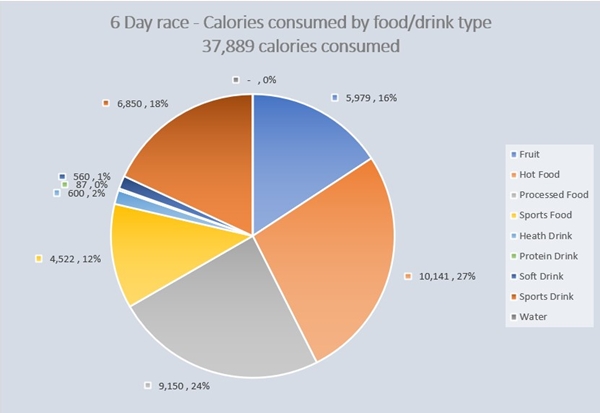
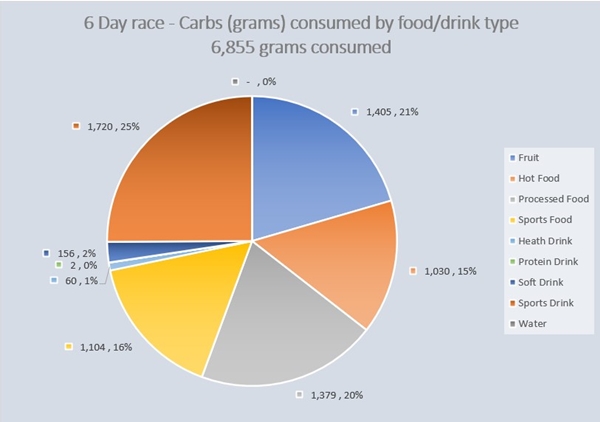
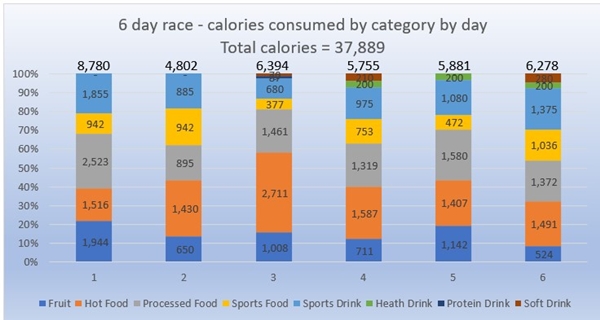
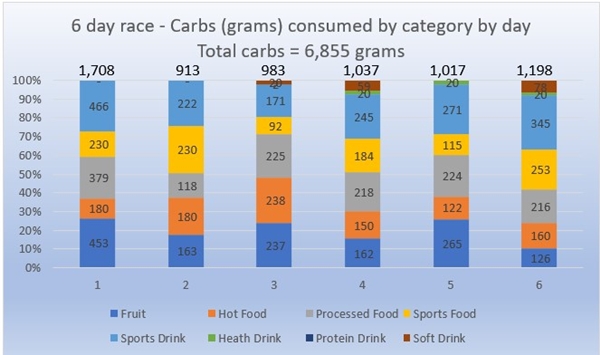
Also, in everyday life I take a few supplements with my breakfast – vitamin D3, magnesium, omega 3 fish oil, a multivitamin, and also iron. So we decided I would take these every twelve hours during the race.
I don’t remember the reason I take each of these, and will discuss the benefits (or otherwise) of these with the sports nutritionist when I meet him in June, but the reason for the iron is that in every race I’ve ever done longer than 24 hours, I’ve always developed mouth ulcers that have hindered my eating in the latter stages of the race. Last year I was told that this could be caused by the constant pounding breaking down something within the blood, and that iron supplementation could help. Well, it didn’t. And we also quickly identified that two iron tablets per day rather than one, was too much. I won’t go into the details as to why 😊
I have never really been keen on sports nutrition and have preferred to consume normal everyday foods during races. This is mainly due to the expense. But when I started planning how I would consume as many calories as I was going to need during the race, I realised that I needed to consume foods that had a high carb to calorie ratio and rather than just drinking water, I needed to be drinking carbohydrate sports drinks.
I obviously expected the weather to be warmer than it was and was budgeting on drinking around 37 litres of carbohydrate drink with water as required.
I ended up drinking 31 ½ of fluid during the race, but 11 ½ of that was water. In the cooler temperatures I should probably have consumed more sports chews and less fluid, and definitely less water.
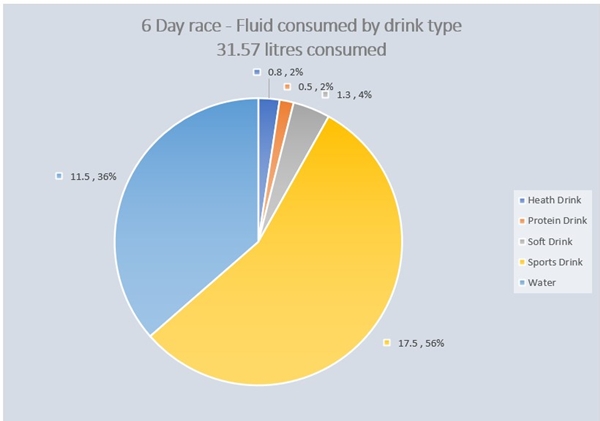
The way I manage my drinking (it sounds like I’m an alcoholic 😊) during the race is that I pick up my bottle – Sarah mixes up 500 ml bottles of both SIS and Tailwind, and also water, and leaves them on our table in the food tent – from the food tent which is just before we head on to the out-and-back stretch, and drink as much as I want at the time – usually about 100 mls – then on the out-and-back stretch there are bollards on the left hand side of the track as we head up to the top loop. The bollards are every 50 metres or so and are a mixture of lower level solar-powered lights standing about 1 metre tall and brick bollards with water taps or power supplies for caravans. When I’ve had enough to drink I place my bottle on the bollard and then collect it next time I need it, drink and leave it on the next bollard.
I don’t know why, but in the three years we have been competing on this circuit, I appear to be the only person that regularly does this. At times I often have two and sometimes three bottles scattered up and down the course. And when the bottle is finished I either leave it back at the food tent or throw it on the lawn in front of the cabin for Sarah to collect and refill.
My plan going into the race was to maintain a minimum intake of 250 calories per hour and 50 grams of carbohydrate per hours. In training in the two months leading up to the race I had trained my gut to tolerate high calorie/carb consumption by consuming up to 400 calories and 90 grams of carbs per hour, which is the quantity I intended to consume during the first 24 to 48 hours, or as long as I could tolerate it.
Day 1 went OK but day 2 was well below expectations before we managed to stabilise over the last four days.
In creating the spreadsheet that Sarah was going to use to record all my food and fluid consumption, I had created some formulae and conditional formatting to highlight in light green when consumption was above the 250 calories/50 grams per hour level on a rolling four hour basis, and dark green when above 300 calories/75 grams per hour.
But we struggled to keep the even level throughout the race that I was aiming for.
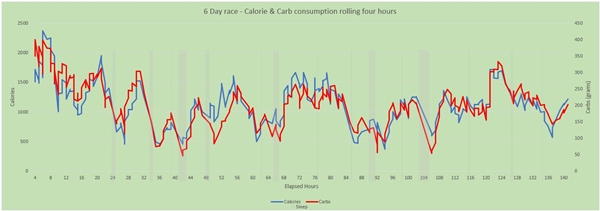
I am sure though, that if I had done this years race, with all the foot problems, and with last year’s nutrition, then there is no way I was have managed the distance I did.
I don’t know how much can be read into this, because of my feet problems, the fact that day 1 mileage and speed is always better than the rest of the race, and all the other factors that impact on the race, but this graph compares average walking speed (distance walked divided by walking hours) each day to the calories and carbohydrates I consumed each day:
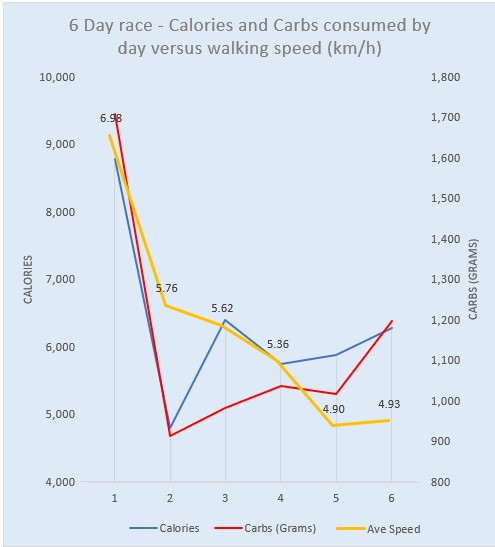
The best six-day racewalking results:
And as well as now having three six-day results over 400 miles, I also have three of the nine best distances in modern-day racewalking (age group world records in bold):
| Ranking | Distance | Name | Nationality | DoB | Age Group | Location | Date |
| 1 | 786k744 | Ivo Majetic | USA | 21.06.68 | M45 | Balaton | 03-09/05/2018 |
| 2 | 752k271 | Dominique Bunel | FRA | 16.11.68 | M45 | Privas | 02-08/08/2015 |
| 3 | 741k212 | John Dowling | IRE | 15.06.29 | M50 | Nottingham | 31-7/6-8/1983 |
| 4 | 711k299 | Richard McChesney | NZL | 14.07.68 | M50 | Vallon Pont d’Arc | 15-21/04/2023 |
| 5 | 710k060 | Christian Mauduit | FRA | 09.06.75 | M35 | Privas | 19-24/10/2014 |
| 6 | 703k133 | Daniel Duboscq | FRA | 16.08.54 | M60 | Privas | 02-08/08/2015 |
| 7 | 701k892 | Alain Grassi | FRA | 21.07.59 | M50 | Antibes | 6-12/06/2010 |
| 8 | 671k029 | Richard McChesney | NZL | 14.07.68 | M55 | Vallon Pont d’Arc | 20-26/05/2024 |
| 9 | 667k357 | Richard McChesney | NZL | 14.07.68 | M50 | Vallon Pont d’Arc | 07-13/05/2022 |
| 10 | 665k225 | Dominique Naumowicz | FRA | 28.03.63 | M45 | Antibes | 5-11/06/2011 |
| 11 | 665k175 | Yolanda Holder | USA | 08.05.58 | W60 | Milwaukee | 25-31.08.2019 |
| 12 | 660k590 | Yolanda Holder | USA | 08.05.58 | W55 | Phoenix | 28/12-02/01/2017 |
So I have to be happy with that.
Comparing my three races at Vallon Pont d’Arc:
I’ve also done some analysis of this year versus 2023 and 2022. All three races were on the same course. I won all three (in the walking division) and the difference between my best and worst distances is only 44km – or 305 metres per hour.
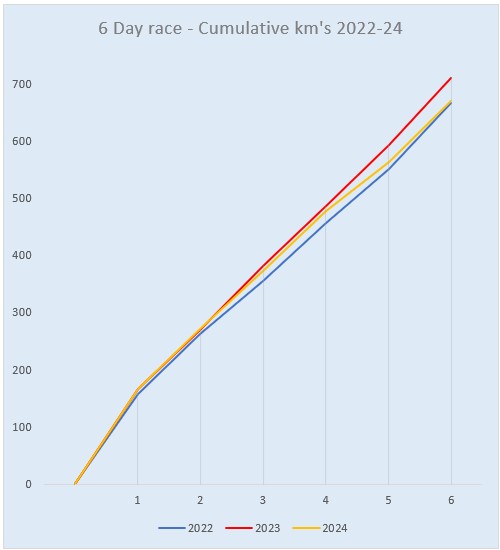
I didn’t record how much sleep I had in 2022, only total downtime – which was 29 ¼ hours (or 20.3% of the total race). Last year I managed to reduce that to 18 ¾ hours with 8 ½ hours of that being sleep, and this year I was in the middle with 25 hours downtime including 13 ½ hours of sleep.
The downtime this year was excessive due to the foot problem but I think I may have found the right amount of sleep – probably around 12 hours with one long (3 hour) sleep mid race and the rest of the sleep breaks being between 20 minute powernaps and 1 ½ hours.
One thing I think will be useful next year will be to bring my first sleep forward to just before breakfast on the first morning – around 18 hours into the race.
Day two is always my biggest problem in multi-day racing, and I think starting the actual day (as opposed to the 24 hour period) with a short sleep just before breakfast will be helpful.
I’m planning on practicing this in a 48 hour race in October.
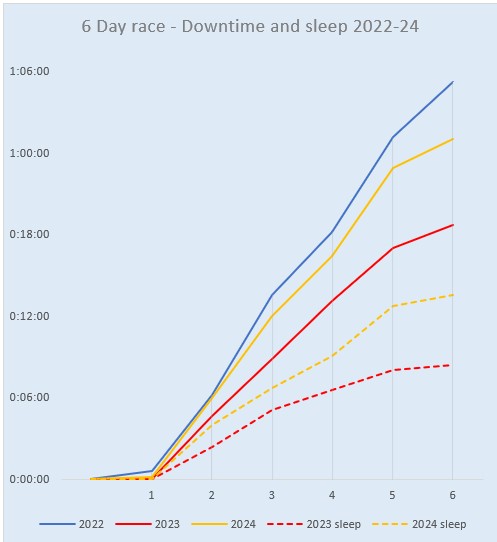
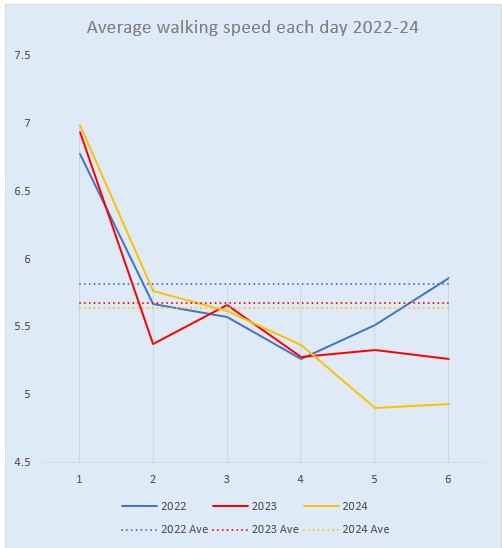
Having now completed 6 six-day races in eight years, to finish a ‘bad’ race with my second best distance is something that I’m proud of. Even if in the back of my mind I still wonder whether I used the foot as an excuse to reduce the pace rather than pushing through the pain.
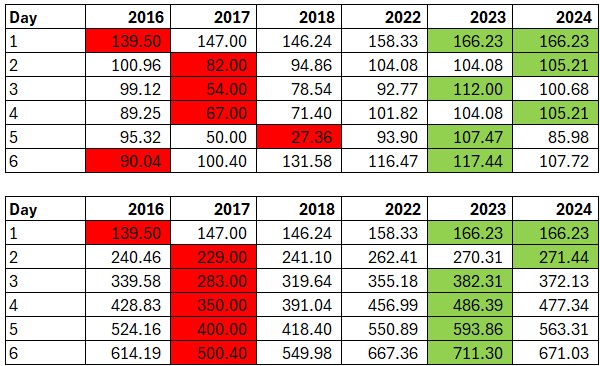
My weight:
Lastly, I’ve been tracking my weight since 2017. This graph shows the ups and downs, and my recent journey from 83kg in May last year up to 93kg and back down to 83kg in May this year – after the race.
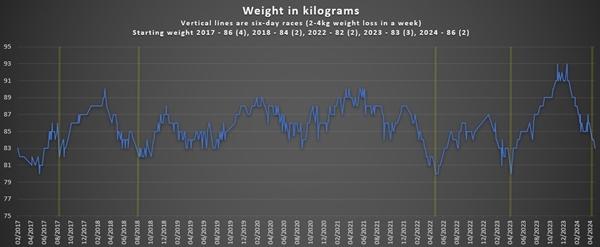
The race winners:
Just a couple more photos to finish off:
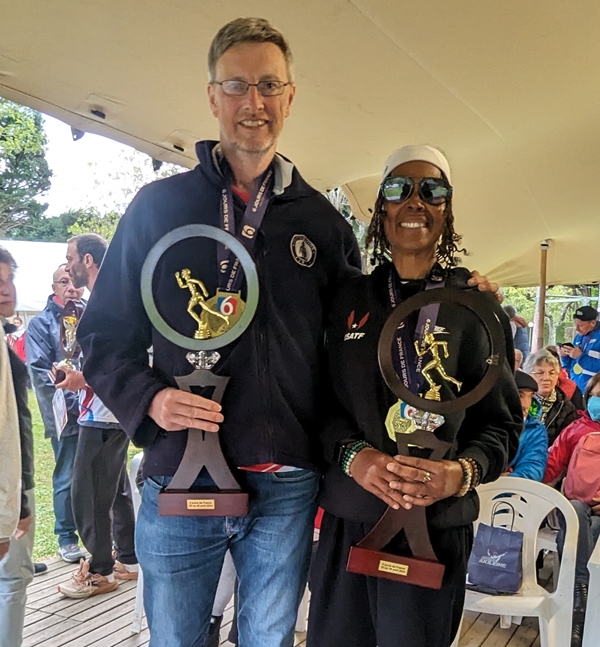
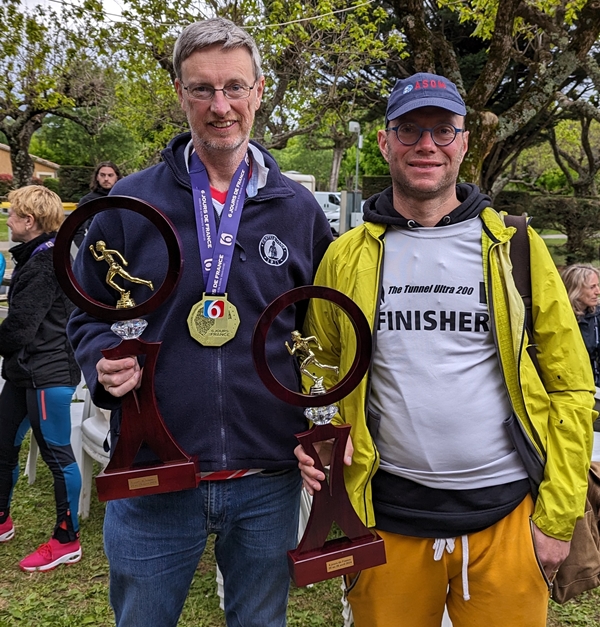
Thanks:
I couldn’t do these races without the support from my wife, Ruth. She makes a lot of sacrifices in the four months leading up to the race. Most nights (including weekends) I’m in bed by 9pm and up again around 4am – trying not to wake her, but only successful 50% of the time.
She also supports me throughout the year with all my races and doesn’t complain when I leave her several weekends plus at least one week per year to go off and compete in races.
And Sarah Lightman, who has travelled with us to support both Kathy Crilley and myself in the last three six-day races. Like me, every year she learns more about how to provide better support, and as a team, it is the two of us that achieve the distances and results that I get the credit for. I’m convinced that Sarah’s support is worth at least an hour per day, and probably much more.
As well as Ruth and Sarah, I don’t know how many people have been a part of my journey in training for and competing in these six-day races. Whether it is phone calls during the race, positive comments on facebook/twitter, or something else. Thanks.
What’s Next:
At the start of this year I had intended on competing in two six-day races during 2024 – Vallon in April and then Balaton (Hungary), where Ivo Majetic set the six-day racewalking world record in 2018, in September. The Balaton race this year doubles as the world six-day running championship and I wanted to compete with the best six-day runners in the world.
But this race took so much out of me mentally, and with the injuries I currently have – I have several minor injuries that I need to recover from as well as the very raw bottom of my right foot – and a planned trip to New Zealand, I’ve decided to take a six week break before I resume training, so have withdrawn from the Hungarian six-day race.
Instead I’m going to race the UK Centurion race in August, which this year will be on the track and is being run in conjunction with the annual 24 hour race in Gloucester – the same event that held the 48 hour race that I dropped out of at 31 hours last year. If my training goes well I want to attempt to break Peter Ballie’s NZ track 100 mile and 24 hour records – 21:04 and 182.6km respectively. These are also the NZ M55 track and overall M55 records.
And then in October I’m going to return to Royan for their 48 hour race which I won in 2018 (with a distance of 278km which I hope to beat). I didn’t enjoy the course or the race in 2018, but it is a 48 hour walking race and my focus will be on improving my day 2 performance due to better nutrition and a short powernap at around 18 hours – which is what I’m planning for next years six-day race.
Thanks for your report “I had all these targets recorded in notepad on my phone so that if things started falling apart, as they were, I could reset my focus and not give up completely.” Keep on walking. Even when it is falling apart.
Thanks for that Richard. Always interesting and plenty to learn from. I must admit, as I was reading about your supplements and that you’d planned to take 2 x iron supplements I was wincing a little. Combined with your early high fibre content, I’d rather not imagine the results!!! Congratulations again
Thanks James
We abandoned the double iron tablets pretty quickly!
A full professional report, nothing less than what I would expect. The detail and analysis is interesting reading. A massive congratulations.
Excellent report Richard. It was so nice to finally meet you in person. Thanks for the advice and the pictures. Best wishes on your next race. Keep moving and smiling.
It was great to finally met you too Yolanda. Maybe again next year?
Brilliant as always Richard. Thank you for sharing
You are an. Inspiration!
Thanks